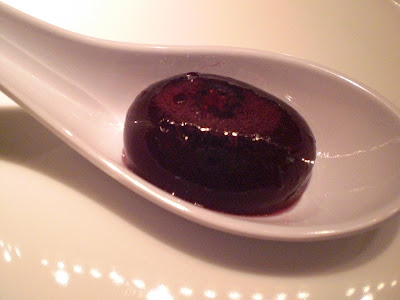 Beginning of service. Among those huddled are chefs with whom Marcel Vigneron has worked at The Bazaar by Jose Andres ("My Last Bite" says he quit and now runs his own catering company, Modern Global Tastings). Those friendlies who introduced themselves to me: to the right of Marcel, Jarrid Massey, and to the far right, Cole Dickinson.
Beginning of service. Among those huddled are chefs with whom Marcel Vigneron has worked at The Bazaar by Jose Andres ("My Last Bite" says he quit and now runs his own catering company, Modern Global Tastings). Those friendlies who introduced themselves to me: to the right of Marcel, Jarrid Massey, and to the far right, Cole Dickinson. Coconut Margarita, on the Cocktail Menu designed by Devin Espinosa, Mixologist at The Tasting Kitchen, Venice, CA. A delightful and smooth, well balanced cocktail. Just right.
Coconut Margarita, on the Cocktail Menu designed by Devin Espinosa, Mixologist at The Tasting Kitchen, Venice, CA. A delightful and smooth, well balanced cocktail. Just right. AMUSE BOUCHE: Pomegranate blueberry spherification.
AMUSE BOUCHE: Pomegranate blueberry spherification. More texturally complex than your typical spherification (Did I just say "typical spherification"?).
One of my favorite flavor combinations. The momo chan--a revelation. This ingredient has appeared on the menu at Saam at The Bazaar.
Most delightful are the candy-colored dollops. They play mind games. Are these different flavors or the same? The colors throw one off. Ha!
A partly Eurasian concept, I thought, as the raviolo tasted like Chinese har gow and the thom kai was reminiscent of both uni and truffles--at least to this jaded palate. Cool!
Detail of interior of langoustine raviolo. The source of "har gow"ness.
The "nesting" egg was witty.
Yummy miso basil taste. Not sure if this impression is an accurate reflection of ingredients. Am wondering if "misohoney" is supposed to be punny, or if I am reading too much in....
Wild. The lamb looks raw, but tastes fantastic, luscious lamby flavor. Marcel is wonderful also at what I call "plate landscaping." This is a style of plating whereby one gets the impression that, if one were miniturized enough to walk on one's plate, one would feel charmed and delighted, as if walking about a garden in the (English) picturesque mode. An excellent practitioner of this style is Grant Achatz of Alinea.
More humor here. The beef gets its animal friendly grass feeding, while the corn used to stuff the less fortunate cattle gets its proper place as an accompaniment. Order has been restored.
Also here, more lusciously cooked meat. Outstanding, this one. And possibly the best plate landscaping of the night (but there is much competition). Note: This is not a view of the presentation side, but rather an attempt to show the most in the photo.
I could barely finish it, but this was delicious, too. Nice send off.
Copyright 2009 Alison Pearlman. All rights reserved.














